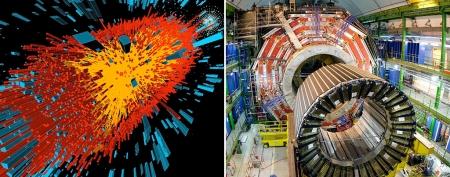July 3, 2012
Physicists at a US laboratory said on Monday they have come tantalizingly close to proving the existence of the elusive subatomic Higgs boson – often called the "God particle" because it may bring mass and order to the universe.

July 3, 2012
Physicists at a US laboratory said on Monday they have come tantalizingly close to proving the existence of the elusive subatomic Higgs boson – often called the "God particle" because it may bring mass and order to the universe.

The announcement by the Fermi National Accelerator Lab outside Chicago came two days before physicists at CERN, the European particle accelerator near Geneva, are set to unveil their own findings in the Higgs hunt. CERN houses the world's most powerful particle accelerator, the Large Hadron Collider (LHC).
The Fermilab scientists found hints of the Higgs in the debris from trillions of collisions between beams of protons and anti-protons over 10 years at the lab's now-shuttered Tevatron accelerator.
But the evidence still fell short of the scientific threshold for proof of the discovery of the particle, they said, in that the same collision debris hinting at the existence of the Higgs could also come from other subatomic particles.
"This is the best answer that is out there at the moment," said physicist Rob Roser of Fermilab, which is run by the US Department of Energy. "The Tevatron data strongly point toward the existence of the Higgs boson, but it will take results from the experiments at the Large Hadron Collider in Europe to establish a firm discovery."
Scientists have worked long and hard to prove the existence of the Higgs boson, the final piece of a model proposed four decades ago laying out the basic building blocks of matter in the universe.
The Higgs particle's presumed power to confer mass seems to endow it with the power of creation itself, which helped lead to its "God particle" nickname. Many physicists loathe the term, fretting that it makes their discipline seem self-aggrandizing.
Physicists not connected to Fermilab expressed cautious optimism that the long-sought particle had finally been found.
"These intriguing hints from the Tevatron appear to support the results from the LHC shown at CERN in December," said Dan Tovey, professor of particle physics at the University of Sheffield in Britain.
"The results are particularly important because they use a completely different and complementary way of searching for the Higgs boson. This gives us more confidence that what we are seeing is really evidence of new physics rather than just a statistical fluke," Tovey added.
Tovey said scientists will have to wait until Wednesday for the latest results from the European scientists before "getting the full picture" concerning the Higgs boson.
'A nice result'
CERN spokesman James Gillies called Fermilab's findings "a nice result," but added that "it will be interesting to see how it lines up with CERN's results on Wednesday. Nature is the final arbiter so we'll have to be a little more patient before we know for sure whether we've found the Higgs."
Tom LeCompte, a scientist at the Department of Energy's Argonne National Laboratory in Illinois who works at CERN and knows the results, said he was confident the Higgs would be shown to exist, or not exist, this year. But he would not say if the findings to be unveiled Wednesday would be definitive.
"I know 2012 is the year. I can't tell you July is the month," LeCompte said.
Others were less cautious. "This is the most exciting week in physics history," said theoretical physicist Joe Lykken of Fermilab.
The Higgs particle is the final quarry in a hunt that began some 40 years ago, when physicists assembled what is now known as the Standard Model. The model is considered the culmination of a quest for the fundamental constituents of matter and the forces that determine how they interact, a search that began some 2,400 years ago with Greek philosopher Democritus' hypothesis that everything is composed of indivisible atoms.
According to the Standard Model, matter is composed of various combinations of six leptons, including the well-known electron and the ghostly neutrino, and six quarks, to which physicists have given whimsical names such as "charm," "bottom," and "strange." The protons at the core of atoms, for instance, are composed of two "up" quarks and one "down" quark.
The Standard Model also includes particles dubbed bosons, which carry nature's four basic forces.
The best-known boson is the particle of light, the photon. It carries the electromagnetic force, which is responsible for such everyday phenomena as the scent of a rose and the pull of a magnet.
Another boson is called the gluon. It binds together the quarks that constitute protons. Without gluons, quarks would stick together no better than an undercooked souffle, atoms would not exist, and neither would stars, planets or life.
Particle accelerators such as those at CERN and Fermilab methodically discovered all the particles predicted by the Standard Model except one.
Square one
The hold-out is the Higgs boson, and its refusal to show itself has long frustrated physicists. The Higgs particle is needed to complete and validate the Standard Model, since if it turns out not to exist scientists would have to figure out the constituents and mechanics of the universe from square one.
Just as importantly, the existence of Higgs was postulated in 1964 to serve a crucial function: conferring mass on some particles that would otherwise have none. Technically, the Higgs particle itself does not provide mass; the particle is, instead, a little knot of matter squeezed out of a force field like a curd forming in soured milk.
The force field is called – of course – the Higgs field. The Higgs field gives mass to some particles but leaves others alone, in a process one might compare to making cotton candy. As the wand is passed through the gossamer cloud of spun sugar, it holds onto more and more of the pink strands.
In much the same way, particles passing through the Higgs field picked up more and more mass, until they became the quarks and leptons and bosons that constitute the stuff of today's cosmos. In this analogy, some wands are oiled, preventing sugar from sticking; these particles remain without mass. Other wands are super-sticky, picking up more than their fair share of mass.
The particle is named after Peter Higgs, now 83, of the University of Edinburgh in Britain, but five other physicists came up with the same idea almost simultaneously.
"The God Particle" was the title of a 1993 book by Leon Lederman, a Nobel-winning physicist and former head of Fermilab, and science writer Dick Teresi. The publisher vetoed titles with "Higgs" or anything else too esoteric. Lederman later said he wanted to call the book "The Goddamned Particle" because the Higgs was so elusive.
Fermilab began its Higgs quest 10 years ago, using its four-mile (6.4 km) circumference Tevatron to smash together protons and their anti-matter twins, anti-protons. When matter meets anti-matter, the two annihilate, leaving behind pure energy.
Out of that energy crystallize new particles. It was in this debris that the Tevatron scientists sought evidence of the Higgs boson.
Because the Higgs is hypothesized to exist for a mere fraction of a second before decaying into other particles, the strategy was to look for these "daughter" particles.
CERN's 16.7-mile circumference LHC, which smashes protons against protons at nearly the speed of light, looks for two high-energy photons. The Tevatron looked for two bottom quarks. Before budget cuts forced it to shut down last September after trillions of proton-anti-proton collisions, it found as many as 1,000 pairs that could have come from Higgs particles.
"It is a real cliffhanger," said physicist Gregorio Bernardi of the Nuclear Physics Laboratory of High Energies in Paris and leader of one of the Tevatron experiments. "We know exactly what signal we are looking for in our data, and we see some evidence for the production and decay of Higgs bosons in a crucial decay mode with a pair of bottom quarks. So we are very excited."
The Tevatron results indicate that the Higgs particle has a mass between 118 and 132 giga-electron volts (the unit of mass-energy used in physics in which 1 GeV is about the mass of the proton). Last year, the LHC pegged the mass at between 115 and 127 GeV.
Courtesy: TOI







































































































